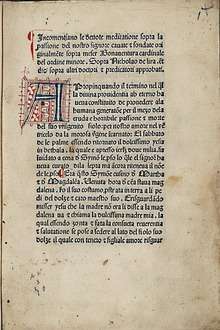Meditations on the Life of Christ
The Meditations on the Life of Christ (Latin: Meditationes Vitae Christi or Meditationes De Vita Christi; Italian Meditazione della vita di Cristo) is a fourteenth-century devotional work, later translated into Middle English by Nicholas Love as The Mirror of the Blessed Life of Jesus Christ.

Authorship
The work's precise date of composition, and its author, has occasioned much debate.[1] Until the late nineteenth century, it was traditionally ascribed to Bonaventure. Once it was realised that the work was not by him, the ascription was changed to pseudo-Bonaventure, and was judged to be of unknown Franciscan authorship.
The editor of the critical edition of the Latin Meditations associated it with a John of Caulibus (Latin: Johannes de Caulibus),[2] an attribution also appearing in the work's most recent English translation.[3] An argument has been made that the Latin work was written around 1300 by Jacobus de Sancto Geminiano, who is also identifiable as the leader of a revolt of Tuscan spirituals, one of the Fraticelli, in 1312.[4][5] It has also been argued that the original version was composed in Italian, perhaps by an Italian nun of the order of Poor Clares.[6][7]
Influence
The work's popularity in the Middle Ages is evidenced by the survival of over two hundred manuscript copies, including seventeen illuminated ones.[8] The popularity of the work increased further with early printed editions, with a surviving Venetian blockbook of 1497.[9]
The work's detailed evocations of moments from the life of Christ and his mother may have influenced early Trecento art. It has also been credited with inspiring the great increase in depictions of the Veil of Veronica from the late 14th century.[10]
References
- McNamer, Sarah (June 2018). ""The Debate on the Origins of the Meditationes Vitae Christi: Recent Arguments and Prospects for Future Research."". Archivum Franciscanum Historicum. 110:1-2: 65–110.
- Stallings-Taney, C. Mary (1997). Iohannis de Caulibus Meditaciones uite Christi, olim S. Bonauenturo attributae. Corpus Christianorum, continuatio mediaevalis. 153. Turnhout: Brepols. ISBN 978-2-503-04532-0.
- Taney, Francis X.; Miller, Anne; Stallings-Taney, C. Mary (2000). Meditations on the life of Christ. Asheville, NC: Pegasus Press. ISBN 978-1-889-81823-8.
- Tóth, Peter; Falvay, Dávid (2014). "New Light on the Date and Authorship of the Meditationes vitae Christi". In Stephen Kelly; Ryan Perry (eds.). Devotional culture in late medieval England and Europe: diverse imaginations of Christ's life. Medieval church studies. 31. Turnhout: Brepols. pp. 17–105. doi:10.1484/M.MCS-EB.5.103036. ISBN 978-2-503-54935-4.
- Falls, David J. (2016). Nicholas Love's Mirror and late medieval devotio-literary culture: Theological politics and devotional practice in fifteenth-century England. London: Routledge. pp. 39–42. ISBN 978-1-317-08755-7.
- McNamer, Sarah (October 2009). "The Origins of the Meditationes vitae Christi". Speculum. 84 (4): 905–955. doi:10.1017/S0038713400208142.
- McNamer, Sarah (2018). Meditations on the Life of Christ: The Short Italian Text. Notre Dame, Indiana: University of Notre Dame Press. ISBN 9780268102876.
- Ragusa, Isa; Green, Rosalie B. (1961). Meditations on the life of Christ; an illustrated manuscript of the fourteenth century (2 ed.). Princeton, N.J.: Princeton University Press. ISBN 978-0-691-10031-9.
- "Le devote meditatione sopra la passione del nostro signore". The Metropolitan Museum of Art. Retrieved 24 February 2017.
- Mâle, Emile (1986). Religious art in France: The late Middle Ages. A study of medieval iconography and its sources (5 ed.). Princeton, NJ: Princeton University Press. pp. 26–48. ISBN 978-0-691-09914-9.